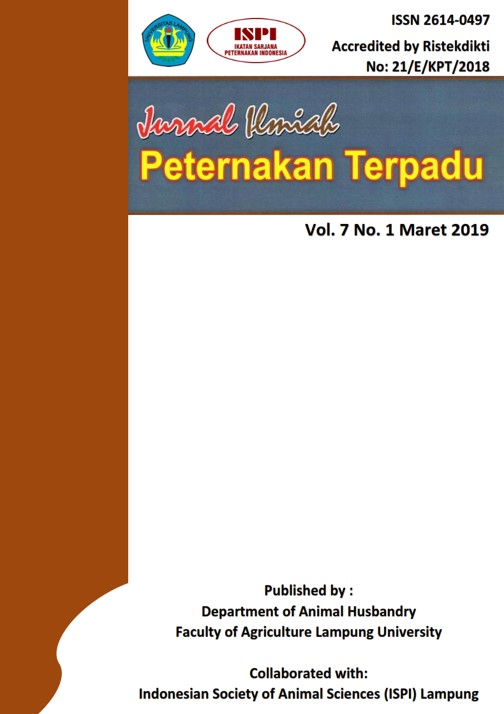IDENTIFIKASI UKURAN TUBUH DAN KUALITAS SEMEN SAPI KUANTAN JANTAN
DOI:
https://doi.org/10.23960/jipt.v7i1.p186-191 Abstract View: 1407
Abstract View: 1407
Abstract
Kuantan cattle is one of the Indonesia's local cattle originating from Riau Province. This research were aimed to determine the average body size and test the fresh semen quality of Kuantan cattle. Measurements of Kuantan cattle body were carried out in 16 adult bulls by observing body length, chest circumference, and shoulder height. Semen quality testing was carried out on four years old bulls with ±150kg weight with the parameters are odor, color, pH, volume, consistency and degrees of viscosity, motility, viability and abnormality. The results showed that the average body size of cattle in Kuantan included body length (cm), chest circumference (cm) and shoulder height (cm) of Kuantan cattle were 88.45 ± 3.92, 119.77 ± 16.18 and 98.94 ± 10.28, while motility, viability, abnormalities were 75.00%, 81.33%, 6.8%. The conclusions of this study were Kuantan cattle body size in small size and the semen feasible to be diluted into frozen semen.
Keywords: Body Size, Semen Quality, Kuantan Cattle
Downloads
Downloads
Published
How to Cite
Issue
Section
License

Jurnal Ilmiah Peternakan Terpadu(JIPT) is licensed under a Creative Commons Attribution 4.0 International License.
Authors who publish with this journal agree to the following terms:
- Authors retain copyright and grant the journal right of first publication with the work simultaneously licensed under a Creative Commons Attribution License that allows others to share the work with an acknowledgement of the work's authorship and initial publication in this journal.
- Authors are able to enter into separate, additional contractual arrangements for the non-exclusive distribution of the journal's published version of the work (e.g., post it to an institutional repository or publish it in a book), with an acknowledgement of its initial publication in this journal.
- Authors are permitted and encouraged to post their work online (e.g., in institutional repositories or on their website) prior to and during the submission process, as it can lead to productive exchanges, as well as earlier and greater citation of published work (See The Effect of Open Access).





















